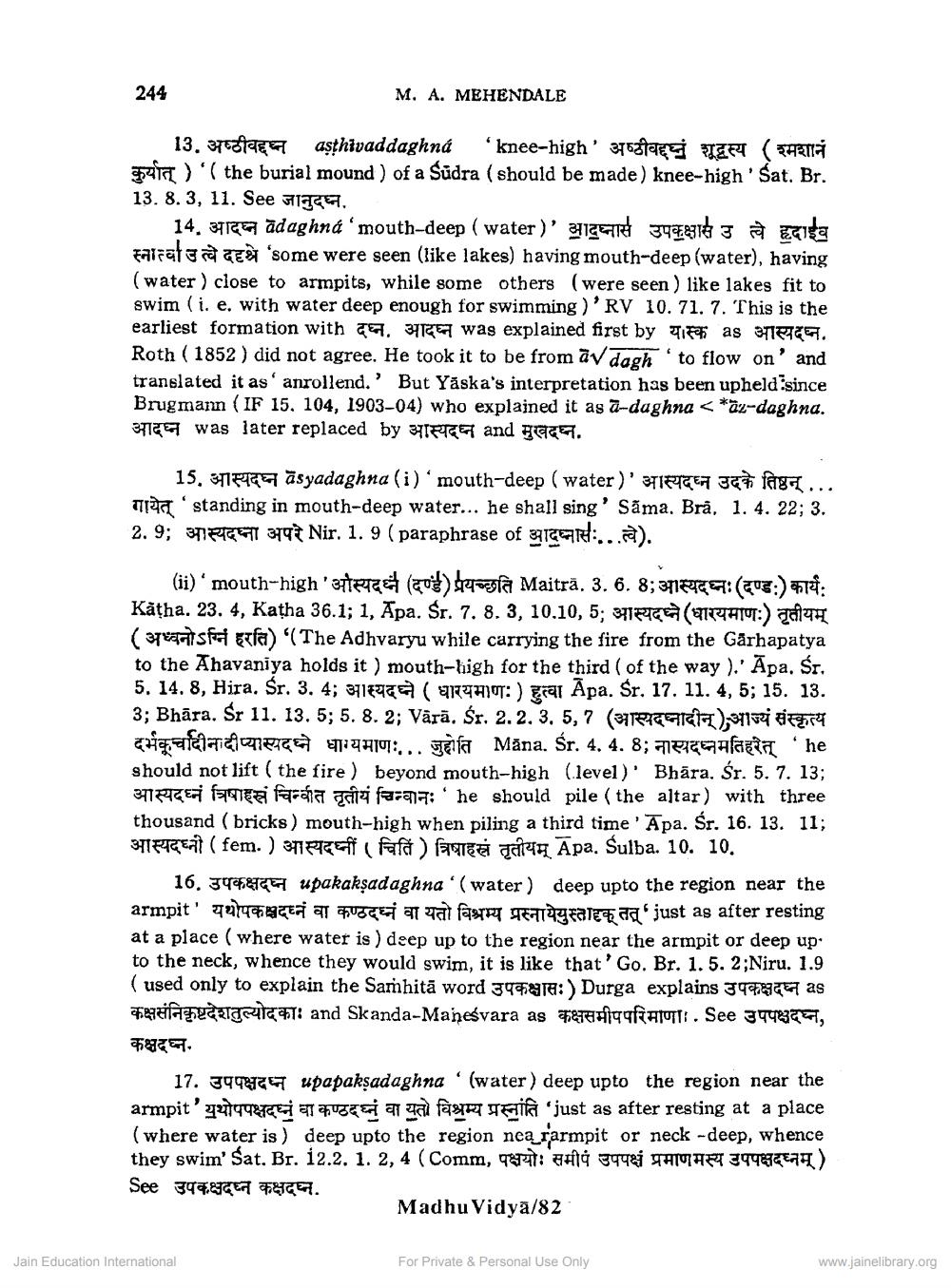________________
244
M. A. MEHENDALE
13. अष्ठीवद्दन asthivaddaghnd knee-high' अष्ठीवद्दष्वं शुद्धस्य (श्मशानं 5215) (the burial mound) of a Sudra ( should be made) knee-high 'Sat. Br. 13. 8.3, 11. See ATCE,
14. 37165 ādaghná 'mouth-deep (water)' NIGER 3429718 a 19 Farat na 'some were seen (like lakes) having mouth-deep (water), having (water) close to armpits, while some others (were seen ) like lakes fit to swim (i. e. with water deep enough for swimming )'RV 10. 71. 7. This is the earliest formation with दन, आदघ्न was explained first by यास्क as आस्यदघ्न. Roth ( 1852 ) did not agree. He took it to be from av dagh 'to flow on' and translated it as' anrollend.' But Yaska's interpretation has been upheld since Brugmann (IF 15, 104, 1903-04) who explained it as d-daghna < *üz-daghna. आदघ्न was later replaced by आस्थदन and मुखदघ्न.
15, 31715 āsyadaghna (i) 'mouth-deep (water)' 3TIFICER # fag... TTIECT'standing in mouth-deep water... he shall sing' Sãma. Brā, 1. 4. 22; 3. 2. 9; 371 REET 3797 Nir. 1. 9 (paraphrase of 3716ER:...).
(ii)' mouth-high 'trae (Col) 44 la Maiträ. 3. 6. 8; 371RCE:(QUE :) #79: Katha. 23. 4, Katha 36.1; 1, Apa. Sr. 7. 8. 3, 10.10, 5; 37TRICE ( TATT:) Jauh ( shefa) (The Adhvaryu while carrying the fire from the Gärhapatya to the Ahavaniya holds it ) mouth-liigh for the third ( of the way ).' Apa. Śr. 5. 14. 8, Hira. Sr. 3. 4; 371697 ARTHOT: ) Eat Apa. Sr. 17. 11. 4, 5; 15. 13. 3; Bhāra. Sr 11. 13. 5; 5. 8. 2; Värā. Śr. 2.2.3, 5, 7 (37TRICETTE), 391021
fadece 941... Safa Māna. Śr. 4. 4. 8; 778 agit 'he should not lift ( the fire) beyond mouth-high (level)' Bhāra. Śr. 5. 7. 13; 377RCE 197 faraja yangi 127217:' he should pile (the altar) with three thousand (bricks) mouth-high when piling a third time 'Apa. Śr. 16. 13. 11; 311FREA (fem.) 311feff Fafa) free datea Apa. Sulba. 10. 10.
16. 3987 upakakşadaghna (water) deep upto the region near the armpit' यथोपकक्षदनं वा कण्ठघ्नं वा यतो विश्रम्य प्रस्नायेयुस्ताक् तत् ' just as after resting at a piace (where water is ) deep up to the region near the armpit or deep up to the neck, whence they would swim, it is like that'Go. Br. 1. 5. 2;Niru. 1.9 ( used only to explain the Samhitā word 3979TA:) Durga explains 397497 as कक्षसंनिकृष्टदेशतुल्योदकाः and Skanda-Manesvara as कक्षसमीपपरिमाणा! . See उपपक्षदघ्न, F1877.
17. 399976 upapakşadaghna '(water) deep upto the region near the armpit'युथोपपक्षदनं धा कण्ठदघ्नं वा यतो विश्रम्य प्रस्नांति 'just as after resting at a place (where water is ) deep upto the region nea_rarmpit or neck - deep, whence they swim' Sat. Br. 12.2. 1. 2, 4 (Comm, 97 g 39921 TATART 39484674) See 398 FHGE.
Madhu Vidya/82
Jain Education International
For Private & Personal Use Only
www.jainelibrary.org




